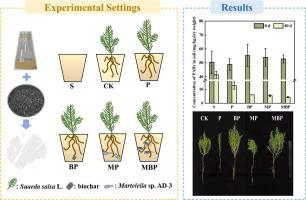Science of the Total Environment ( IF 8.2 ) Pub Date : 2023-04-03 , DOI: 10.1016/j.scitotenv.2023.163279 Changzheng Cui 1 , Jiamin Shen 2 , Yi Zhu 3 , Xin Chen 2 , Siyuan Liu 2 , Jie Yang 4

|
Polycyclic aromatic hydrocarbon (PAH) contaminated saline-alkali soil is commonly salinized and hardened, which leads to low self-purification efficiency, making it difficult to reuse and remediate. In this study, pot experiments were conducted to investigate remediation of PAH contaminated saline-alkali soil using biochar-immobilized Martelella sp. AD-3, and Suaeda salsa L (S. salsa). Reduction in phenanthrene concentration, PAH degradation functional genes, and the microbial community in the soil were analyzed. The soil properties and plant growth parameters were also analyzed. After a 40-day remediation, the removal rate of phenanthrene by biochar-immobilized bacteria combined with S. salsa (MBP group) was 91.67 %. Additionally, soil pH and electrical conductivity (EC) reduced by 0.15 and 1.78 ds/m, respectively. The fresh weight and leaf pigment contents increased by 1.30 and 1.35 times, respectively, which effectively alleviated the growth pressure on S. salsa in PAH-contaminated saline-alkali soil. Furthermore, this remediation resulted in abundance of PAH degradation functional genes in the soil, with a value of 2.01 × 103 copies/g. The abundance of other PAH degraders such as Halomonas, Marinobacter, and Methylophaga in soil also increased. Furthermore, the highest abundance of Martelella genus was observed after the MBP treatment, indicating that strain AD-3 has a higher survival ability in the rhizosphere of S. salsa under the protection of biochar. This study provides a green, low-cost technique for remediation of PAH-contaminated saline-alkali soils.
中文翻译:

生物炭固定化中度嗜盐菌联合碱蓬对盐碱地菲的生物修复。
多环芳烃(PAH)污染的盐碱地普遍盐碱化、板结,自净效率低,难以回用和修复。在这项研究中,进行了盆栽试验,以研究使用生物炭固定化Martelella sp修复 PAH 污染的盐碱土壤。AD-3 和碱蓬L(S. salsa)。分析了菲浓度的降低、PAH 降解功能基因和土壤中的微生物群落。还分析了土壤特性和植物生长参数。修复40天后,固定化生物炭菌结合莎莎沙司对菲的去除率(MBP 组)为 91.67%。此外,土壤 pH 值和电导率 (EC) 分别降低了 0.15 和 1.78 ds/m。鲜重和叶色素含量分别提高了1.30倍和1.35倍,有效缓解了莎莎在PAH污染盐碱地的生长压力。此外,这种修复导致土壤中存在大量 PAH 降解功能基因,其值为 2.01 × 10 3拷贝/g。土壤中其他多环芳烃降解物的丰度也有所增加,例如盐单胞菌属、海杆菌属和甲基噬菌体。此外, Martelella的丰度最高MBP处理后观察到该属,表明菌株AD-3在生物炭的保护下在莎莎根际具有较高的存活能力。该研究为PAH污染的盐碱土壤修复提供了一种绿色、低成本的技术。






























 京公网安备 11010802027423号
京公网安备 11010802027423号